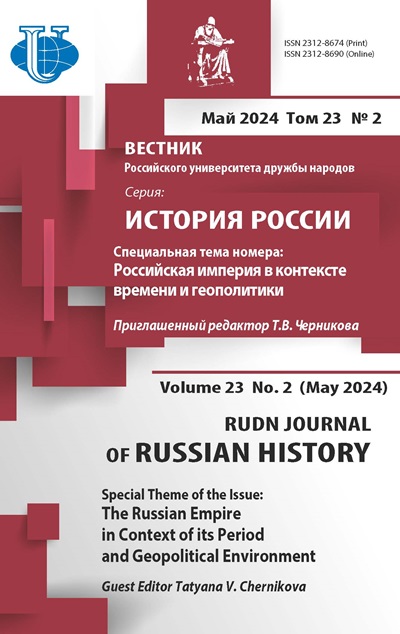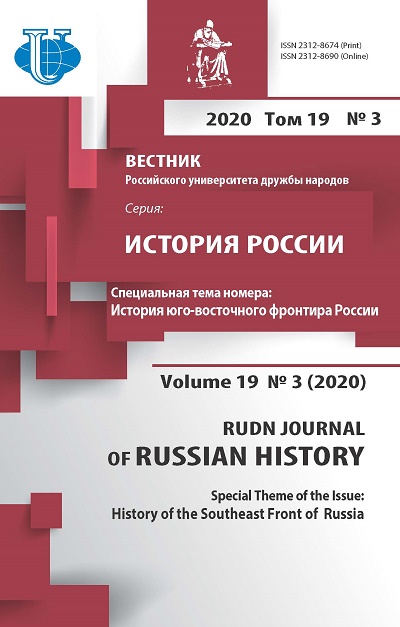История юго-восточного фронтира России: актуальные проблемы, современные подходы к их решению
- Авторы: Любичанковский С.В.1,2
-
Учреждения:
- Оренбургский государственный педагогический университет
- Самарский федеральный исследовательский центр Российской академии наук
- Выпуск: Том 19, № 3 (2020): ИСТОРИЯ ЮГО‐ВОСТОЧНОГО ФРОНТИРА РОССИИ
- Страницы: 520-524
- Раздел: В ЭТОМ НОМЕРЕ
- URL: https://journals.rudn.ru/russian-history/article/view/24445
- DOI: https://doi.org/10.22363/2312-8674-2020-19-3-520-524
Цитировать
Полный текст
Аннотация
-
Полный текст
Уважаемый читатель! Предлагаемая Вашему вниманию специальная рубрика приурочена к 285-летию с момента первого основания города Оренбурга (Орска) 26 августа 1735 г. и посвящена истории становления и развития юго-восточного фронтира России, определяемого, в общем и целом, внешними границами Оренбургского края и сопредельных территорий. Методологической основой рубрики является концепция «фронтирной модернизации», то есть развития присоединяемых либо пограничных территорий России с целью повышения их политико-правового и социально-экономического уровня до состояния наиболее развитых регионов страны в условиях незавершенного освоения1, то есть в отношении территорий, лишь частично интегрированных в политико-правовое пространство государства, осуществляющего модернизационную политику. В рамках данной проблематики в центре внимания авторов номера оказались ключевые вопросы, связанные с межкультурным (межнациональным и межконфессиональным) взаимодействием на территории исторического Оренбургского края – огромного макрорегиона, игравшего и в дореволюционный, и в советский периоды роль фронтира в треугольнике «Русский мир – Башкирия – Казахская степь». Основное внимание сориентировано на такие вопросы, как история закрепления за Россией кочевых и полукочевых народов степи, феномен оренбургского и уральского казачества, политика по отношению к «инородцам» и становление национальных интеллигенций, имперская и советская национальная политика в регионе, межкультурное взаимодействие в рамках освоения целины.
Рубрика выстроена, во-первых, в логике хронологического подхода, а во-вторых, по принципу перехода от внешней политики к внутренней (для фронтирных исследований, часто сложноотделимых друг от друга). Она открывается новаторской статьей С.В. Джунджузова, который впервые в исторической науке комплексно и системно рассмотрел биографию Петра Тайшина – чрезвычайно знаковую для понимания процесса включения Калмыкии в орбиту Российского государства. Автору удалось реконструировать процесс интеграции и аккультурации на примере конкретного представителя «инородческой» элиты, а также убедительно показать, что именно «дело П. Тайшина» стало для имперского правительства конкретным поводом для корректировки правительственного курса в отношении крещеных калмыков, благодаря чему в итоге и в Калмыцком ханстве исчез очаг социальной напряженности, и империя приобрела людские ресурсы для заселения пустующего пространства в Среднем Поволжье, а позднее и в Оренбургской губернии. Исследователь доказал, что созданные благодаря П. Тайшину поселения калмыков на Средней Волге внесли существенный вклад в хозяйственное освоение и обеспечение обороны обширного Оренбургского края.
Тема отражения внешних связей на ходе процесса фронтирной модернизации продолжается статьей Е.В. Бурлуцкой и К.А. Абдрахманова, в которой раскрыта специфика трудовой повседневности оренбургских купцов, ведущих торговлю с Азией в XIX в. Созданное в рамках научного направления «история повседневности» данное исследование раскрывает различные сложности купеческого труда, связанные как с неблагоприятными природно-климатическими условиями для организации эффективной караванной торговли, так и с тем, что оренбургским коммерсантам приходилось одновременно осуществлять функции организатора и исполнителя этой караванной торговли, а также контролирующей инстанции, и переживать значительные физические лишения и психологический дискомфорт.
Переходя от сюжетов, отражающих внешнеполитические и внешнеторговые особенности политики модернизации на юго-востоке России, к внутриполитическим аспектам интеграции региона в состав единого имперского социокультурного пространства, невозможно обойти вниманием такую изначально «фронтирную» социальную группу, как казачество. Статья Е.В. Годововой раскрывает основные направления экономической повседневной казачьей жизни юго-восточного фронтира России в пореформенный период, когда темпы модернизации существенно возрастают. Автор реконструировала изменения, которые негативным образом затронули повседневную жизнь оренбургского казака, однако при этом меняли его агрономическое сознание. Автором показано, как в условиях фронтирной повседневности формировался тип «казака-воина» – «казака-земледельца», жизнь которого была полна трудов и забот, особенно в летнее время, а доходы подвержены риску вследствие неурожаев. При этом с течением времени нерациональное использование земли и частые неурожаи приводили к снижению уровня жизни населения, затраты же на военную службу возрастали, а существующий порядок частых земельных переделов все более мешал рационализации экономического уклада оренбургского казачества.
Важнейшей стороной развития юго-восточного фронтира России являлась модернизация и приспособление под местные специфические условия системы регионального управления и самоуправления. Этой стороне проблемы в данной спецрубрике посвящены две статьи. Одна из них, принадлежащая перу И.А. Коновалова, тематически продолжает исследование Е.В. Годововой, поскольку тоже посвящена внутреннему устройству казачьего сословия, а конкретно – особенностям местного самоуправления казаков, проживавших на территориях, связывающих юг Западной Сибири и север Казахской степи. В этой статье убедительно показана эволюция казачьего самоуправления в зависимости от условий того или иного конкретно-исторического периода; показана особая роль низового, станичного казачьего самоуправления в условиях отсутствия на изучаемых территориях земств, даже при наличии излишней бюрократической опеки со стороны государственных структур.
Статья Д.В. Васильева и А.В. Рябова также посвящена внутриполитическому устройству юго-восточного фронтира, однако в совершенно ином ключе – через проблему визуализации имперского пространства. Проанализировав практику встреч коренных жителей Туркестанского края с представителями царствующего дома Романовых и высшей правящей верхушкой региона, авторы реконструировали одну из конкретных технологий интеграций инокультурной территории в общее социокультурное пространство империи, суть которой заключалась в символическом подчеркивании единения российской монархии и народов Центральной Азии целым рядом церемоний. Как убедительно показывают авторы статьи, это позволило достаточно эффективно внедрять на данной территории идеологему «самодержавие – православие – народность», несколько скорректировав ее срединное звено, что было чрезвычайно важно в условиях преобладания ислама в регионе.
Статья С.А. Алешиной и Л.В. Петрич на материалах Оренбуржья акцентирует внимание на элементах преемственности в национальной политике дореволюционного и советского периодов, которые долгое время отрицались или замалчивались в историографии. Авторы сфокусировались на анализе просветительной и образовательной работы среди взрослого нерусского населения региона в период с конца XIX в. и вплоть до конца 1930-х годов. Исследователям удалось показать, что политика ликвидации неграмотности на юго-восточном фронтире являлась, в общем и целом, единым процессом, и советский ее этап был основан на достижениях этапа имперского. Авторы также убедительно доказали, что и имперская, и советская власть сталкивались при решении данных задач с похожими трудностями, среди которых основными являлись нехватка учительских кадров и некоторое сопротивление со стороны местного нерусскоязычного населения.
В исследовании Е.В. Пахомовой процесс освоения целины, теснейшим образом связанный с историей именно Оренбургского края и Северного Казахстана, рассмотрен как особый фронтирный процесс. Такая оригинальная постановка вопроса позволила автору сделать вывод о том, что освоение новых земель привело к формированию уникального целинного микросоциума, воспроизводившего многие черты фронтирных сообществ. Возникшая в ту эпоху метафора «целинный меридиан» подразумевала в том числе и феномен «нового пограничья», сдвинувшего границы «дикого поля». В Оренбуржье, по обоснованному мнению исследователя, фронтирная специфика на территории массового освоения целины была изжита только в середине 1960-х гг.
В целом представленная вниманию читателя специальная тематическая рубрика представляет собой ценный вклад в историю изучения юго-восточного фронтира России как с точки зрения введения в научный оборот новых источников, так и с точки зрения новизны интерпретации уже известного материала. Представленные в ней статьи являются срезом современной историографии проблематики; они определяют новые теоретические и конкретно-исторические направления в исследовании юго-восточного фронтира России и в этой связи затрагивают историю не только России, но и ряда соседних государств и поэтому, несомненно, привлекут внимание широкой научной общественности.
1 Побережников И.В. Фронтирная модернизация как российский цивилизационный феномен // Модернизация в цивилизационном контексте: российский опыт перехода от традиционного к современному обществу / Отв. ред. В. В. Алексеев. Екатеринбург: Наука Сервис, 2011. С. 47–61.
Об авторах
Сергей Валентинович Любичанковский
Оренбургский государственный педагогический университет; Самарский федеральный исследовательский центр Российской академии наук
Автор, ответственный за переписку.
Email: kaf_rushistory@ospu.su
доктор исторических наук, профессор, заведующий кафедрой истории России Оренбургского государственного педагогического университета. Ведущий научный сотрудник отдела истории и археологии Самарского федерального исследовательского центра Российской академии наук. Почетный работник сферы образования Российской Федерации.
460844, Россия, Оренбург, ул. Советская, 19; 443001, Россия, г. Самара, Студенческий переулок, 3АСписок литературы
















